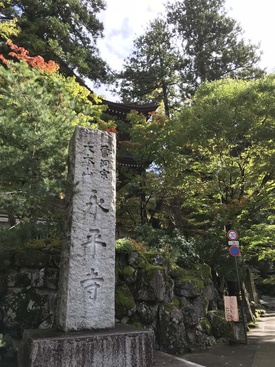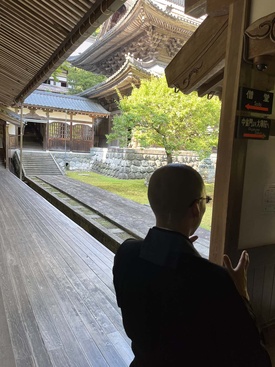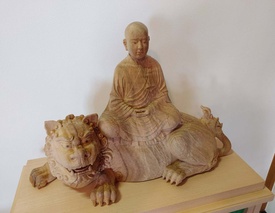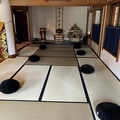Haunting drumbeats from the soundtrack of Lost in Translation put me into a nostalgic trance as I sped through the Japanese countryside at 178 miles per hour. I had just met a woman who worked on this film about two Americans stranded in Tokyo, and we planned to dine at the stylish Shinjuku hotel where Bill Murray and Scarlett Johansson’s characters fall in love.
But before our date could take place, I was scheduled to live like a monk for five days in the mountains along the Japan (East) Sea. A bullet train was whisking me away to Eiheiji, the country’s “most rigorous Zen temple.”
Although I grew up Buddhist in Southern California, I knew nothing about Zen until later in life. My family’s Buddhism was not centered on zazen meditation; nor did its priests train in monasteries like Eiheiji, where since 1244 monks have isolated themselves from the pleasures and conveniences of the outside world and maintained a strict daily regime complete with zazen and scores of services, rituals, and practices. While monks can now marry, have families, and choose the diet that suits them, when practicing at Eiheiji they must follow the original Buddhist vows of celibacy and vegetarianism.
Seventeen of us foreigners who were inspired by Soto Zen in our home countries came as pilgrims to Eiheiji, the original source from which it spread throughout Japan—and then abroad. Most of the practitioners were Europeans, with several Americans and Australians, and one person each from Lebanon and Hong Kong. After registering and surrendering our smartphones, we did almost everything communally and usually in silence (zazen, lectures, services, eating, bathing, sleeping, and cleaning).
Upon meeting my fellow practitioners, I wasn’t surprised that over a third were women since gender balance was common at Zen centers outside of Japan. What surprised me, however, were the two Japanese nuns assigned to our group. I had sat zazen with many male Japanese monks back home in Los Angeles, but no nuns. As a result, I didn’t have a concept of a Japanese female monk.
One of the nuns, the younger one as it turned out, sat next to me in the zendo. For the first two days, I was unsure if she was male or female. Her shaved head, androgynous face, and robes gave no clues as to her sex. It was not like she was wearing make-up, lipstick, perfume, or yoga pants.
I remember this nun for her selfless generosity. In the pre-dawn stillness, she and I brought up the rear of a line of practitioners walking up countless flights of immaculately polished wood stairs to the Dharma Hall. While we waited at the entrance for morning service, I realized that I had forgotten my prayer book. I had set it down in haste to rearrange my kimono-styled top that had been put on wrong.
“Excuse me,” I said to the nun. “I forgot my prayer book.”
Without thinking she reached into her robes and handed me her copy. Perhaps she had memorized the sutras and chants and didn’t need her book. Still, I was impressed by her alacrity.
If I was her, I’d stop to think, “Is there an extra book in the hall? Could he share one with someone else?” Irritation might flash. “We reminded you to bring that with you!”
As for the other nun assigned to our group, I had no problem recognizing her sex. Mana assisted the head monk and spoke to us about the daily schedule. She also called out instructions about the rituals and rules to follow in the zendo. We all enjoyed Mana’s warmth, approachability, enthusiasm, and command of English.
During a break, when we were allowed to chat, she handed her business card to me and to a German woman, and then invited us to visit her temple in Tokyo.
That evening on the way to the study hall I was happy to hear that Mana would give the day’s lecture, and that it would be about her life. I passed on the news about Mana’s talk as we practitioners removed and aligned our slippers in front of the hall. We didn’t know what to expect, but soon she had us riveted to the tatami mats.
Mana was one of the first female teachers at Eiheiji, which had remained a men’s monastery since its founding. She began her spiritual journey as a Catholic nun, living cloistered in a convent outside of Tokyo where she experienced “great joy that I had never felt in this world.” Although she left the convent and became a Buddhist, religious exaltation remained at the center of her practice.
I was blown away. Her faith seemed to transcend the boundary between Buddhism and Christianity, which gave it an alluring purity. If my life was a movie, the scene would cut from Mana’s talk to a dream sequence: I arrive at the hotel featured in Lost in Translation to discover that my date has shaved her head and is wearing black and saffron robes.
Upon leaving the study hall, I became determined to learn more about Mana as well as the lives of Zen nuns. I caught up with the junior nun who the day before had handed me her prayer book.
“Excuse me,” I said. “I’m sorry if this is an offensive thing to ask. I know that Zen monks can get married. What about nuns?”
“Yes. It is possible for us to marry,” she said. “But we seldom do.”
A few days after returning to Tokyo, I sent Mana an email thanking her for teaching us at Eiheiji. Silence.
How does a foreign layman strike up a relationship with a celibate Buddhist nun?
As I discussed Mana’s talk with practitioners from my Tokyo zazen group, a plan emerged. They were eager to meet the woman who had left a Catholic convent for a Buddhist women’s monastery.
My friend Yayoi was particularly excited to meet a nun whose temple was close to her house. “I wonder if Mana Sensei is like Jakucho Setouchi?” she asked, quickly noticing the blank look on my face. Yayoi tapped her phone and showed me a photo of perhaps the most famous living nun in Japan.
Before her ordination at age 51, Setouchi had been a pioneering novelist at the peak of her fame. She had scandalized the Japanese public by writing about sex from a woman’s perspective. Not just that, she wrote a story based upon her own experience of divorcing her husband, a university professor, after having an affair with one of his students.
“Usually people who do bad things make good writers,” she once said. “I did a lot of bad things, which is why my novels are interesting.”
Upon taking the vow of chastity, Setouchi gave up her former free-wheeling ways. “I entered the clergy not because I wanted to renounce this world.” Nay. She didn’t become indifferent to romantic relations, but rather refocused her life to pursue “something greater.”
After shaving her head, Setouchi continued to call for gender equity, insisting that women should obtain economic independence from men. In this way, if they divorced, they could retain custody of their children—something she couldn’t do and regretted.
Reflecting on her life at age 84, Setouchi was glad to have become a nun, but lamented having done so while she was still full of sexual energy. “I had no idea I was going to live so long.”
I sent a second email to Mana—this time saying that I’d like to bring members from my zazen group to her temple. I received a warm reply. She not only welcomed us to visit her temple but also invited us to sit zazen with a group of Buddhist nuns visiting from Switzerland, and then stay for dinner.
Eight members from my zazen group joined me at Mana’s temple. We met five Swiss nuns, as well as Mana, her junior colleague (whom I knew from Eiheiji), and the abbess of Mana’s temple. Even though we came from all over the world (Germany, Ireland, Korea, Vietnam, France Switzerland, Japan, and the US), most of us spoke English and each of us was a Soto Zen practitioner.
We were all delighted to discover that the visiting nuns’ leader shared a Zen lineage with the two organizers of my zazen group. Their master in Japan, Sato Sensei, and hers in France were both Dharma brothers (classmates) taught by the same well-known wandering monk. I marveled at the global web of relations that had already connected Mana and me.
During dinner, Mana and I chatted with Yayoi about Sato Sensei, the deceased founder of my zazen group. Yayoi had lived in his dojo training facility with him and other practitioners. She also had joined Sato Sensei when he gave talks on Buddhism around Japan and even overseas.
“I fell in love with him,” she said.
“That’s a strange way of putting it,” I interjected. “Falling in love with a Zen master.”
“But you said the same thing about Mana. That you fell in love with her after hearing her talk at Eiheiji.”
Yikes. I forgot I told her that. Noticing the startled look on my face, Yayoi quickly dropped the subject, even as Mana sat impassively silent.
A few days later, Yayoi and I laughed about this incident as I confessed that I was indeed smitten with Mana. At this point in the movie of my life I would’ve loved to see a montage showing increasingly intimate images of Mana and me interacting, accompanied by upbeat guitar strumming: She and I sitting zazen, chanting the Heart Sutra, eating sandwiches that she prepared, and walking her dog Kumi. But that would be a movie.
The reality, I told Yayoi, was that I needed to let go of romantic delusions. I wasn’t so stupid to think that Mana and I could become a couple. I was looking for a conventional romance because I wasn’t a monk and was resigned to dwell in the world of samsara, the Buddhist term for “the cycle of aimless drifting, wandering, or mundane existence.”
Yayoi sat stone faced. She told a story about an ostensibly celibate nun who had lived at Sato Sensei’s dojo. During the day she was the picture of Zen rectitude, but at night she changed into street clothes and snuck out to meet her lover.
“What if Mana was like this nun or perhaps like Jakucho Setouchi who regretted shaving her head before her sexual desires were exhausted?”
That night on the train home from Yayoi’s place I received a text from the woman who had worked on Lost in Translation. Our Shinjuku dinner, which took place just after I had returned from Eiheiji, didn’t live up to the hype. As a result, I had stopped listening to songs from the film soundtrack. Sigh.
I put my phone away and straightened my back with eyes half closed and hands together in my lap forming an oval known as the “cosmic mudra.” I called this posture PDZ—public display of zazen. After a few minutes, the Tokyo nightscape blurred into soft pulsating lights and the robo-conductor’s voice whispered the coming station names one after another until her voice faded into the din.
Ding.
My phone awakened me to the surroundings. People shuffled on and off the train. School girls in white sweaters and plaid skirts talked in a circle. A salaryman slept chin down, while a young couple sharing ear buds bopped heads to unheard beats.
Thoughts about Mana, romance, and beginning a new life in Japan floated out of my consciousness, leaving only the bright white samsara of a late-night commuter train. When the doors opened at my stop, I strode into the florescent fall night, unsheathing my smartphone with alacrity and purpose.
© 2023 Lon Kurashige










